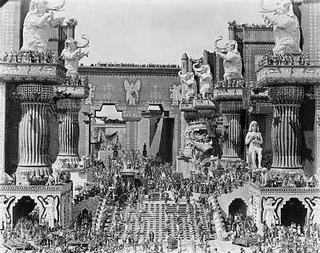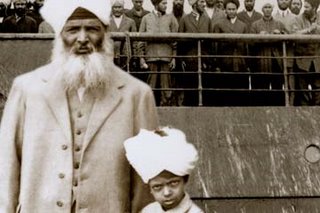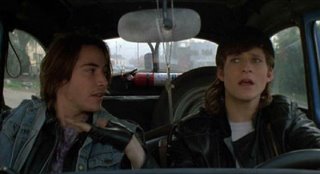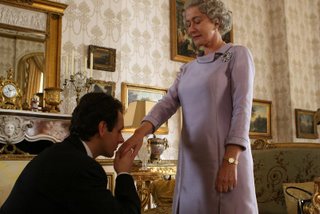NOTE: THIS ENTRY HAS BEEN SALVAGED FROM THIS SITE AND REPOSTED UNEDITED ON 5/22/2008. SOME INFORMATION MAY BE OUTDATED, AND OUTGOING LINKS HAVE NOT BEEN INSPECTED FOR REPUBLICATION. COMMENTS CAN BE FOUND HERE.
I suspect this post can be filed under the category of "too little, too late", but I've finally found a free moment to mention something I've been meaning to here for a while now.
 The Roxie Cinema is among the contenders in a contest called Partners in Preservation, set up to determine how to distribute funds to help restore and preserve historic sites in the Frisco Bay Area. Anyone, no matter their location, is encouraged to set up an account and vote once a day, every day until October 31st. I hope everyone who reads this will do just that.
The Roxie Cinema is among the contenders in a contest called Partners in Preservation, set up to determine how to distribute funds to help restore and preserve historic sites in the Frisco Bay Area. Anyone, no matter their location, is encouraged to set up an account and vote once a day, every day until October 31st. I hope everyone who reads this will do just that.On the first day I learned about the contest, the Roxie was in first place, but since then it's steadily slipped down and is now out of the top ten (which I understand is where the theatre needs to be if it is to receive some of the funds.) I admit I haven't remembered to vote every day, and I even voted for another project once or twice while the Roxie was still at the top of the list, thinking that the independent cinema lovers who turned out initially would be a strong enough contingent to ensure its high placement throughout the polling.
An interesting aspect of the poll is that as you vote you can select a reason why you made your particular choice. Voters for the Roxie have tended to choose it because "it contributes to the vitality of the Bay Area" (as of now, 41%) or because "Saving it will improve the community" (25%) more often than because "it has historic or architectural significance" (20%). 20% is one of the lowest ratios in the latter category for any of the projects in the poll, and I suspect it's indicative of why the cinema has not ranked higher after that initial push. It's true that the building is not as striking or ornate a structure as, say, Oakland's shuttered Fox Theatre (currently holding at number four in the poll), but I for one think the Roxie, as Frisco's oldest theatre still in operation, is extremely historically and architecturally significant.
The Roxie and the 4-Star (which was twinned, non-identically, in 1996) are the only currently operating movie theatres in Frisco built specifically to show movies from what one might call the "pre-epic" era of cinema. Films were made for twenty years before the medium "came of age" as something for everyone up to and including the President of the United States, not to mention the NAACP, to take seriously, when The Birth of a Nation was released. Italian extravaganzas such as Cabiria had been imported here before, but the The Clansman (as it was originally called) was three hours long, used the most modern cinematic techniques of its day, and was controversial, to put it mildly. Incendiary may be a better word. These factors helped make it more than just a "blockbuster" film but a phenomenon that truly outlasted its moment. By March 8, 1915, the second of at least fourteen weeks at the long demolished O'Farrell Street Alcazar Theatre (which usually hosted theatre and opera at the time but made an exception for this film) it was already being advertised as "the World's Most Famous Motion Picture". To this day it's surely the most well-known film title of the silent era.
 Of course the biggest cultural event in Frisco in 1915 wasn't a film but a fair: the Panama Pacific International Exposition which opened shortly before the Clansman did at the Alcazar, but outlasted the film's run there, continuing nearly all year. Stuart Klawans opens his book Film Follies with an appealing hypothesis that D.W. Griffith used the fair's architecture, a remnant of which still exists as the Palace of Fine Arts, as part of the inspiration for the gargantuan scale of Intolerance, his 1916 rejoinder to critics trying to censor the Birth of a Nation (Frisco's Board of Supervisors were among those who attempted this at the time). Intolerance was not the box office hit the previous feature was, but as Klawans points out, it wasn't the financial disaster it's been made out to be either, and it helped to inspire a wave of lavish historical epics. Interestingly, at around the same time a new type of movie theatre was emerging on the scene: the movie palace, grand and ornate, and designed to attract upscale customers to motion pictures.
Of course the biggest cultural event in Frisco in 1915 wasn't a film but a fair: the Panama Pacific International Exposition which opened shortly before the Clansman did at the Alcazar, but outlasted the film's run there, continuing nearly all year. Stuart Klawans opens his book Film Follies with an appealing hypothesis that D.W. Griffith used the fair's architecture, a remnant of which still exists as the Palace of Fine Arts, as part of the inspiration for the gargantuan scale of Intolerance, his 1916 rejoinder to critics trying to censor the Birth of a Nation (Frisco's Board of Supervisors were among those who attempted this at the time). Intolerance was not the box office hit the previous feature was, but as Klawans points out, it wasn't the financial disaster it's been made out to be either, and it helped to inspire a wave of lavish historical epics. Interestingly, at around the same time a new type of movie theatre was emerging on the scene: the movie palace, grand and ornate, and designed to attract upscale customers to motion pictures.Up until a few weeks ago there were two such theatres in Frisco still showing films and essentially architecturally unchanged (that is, still operating as single-screen theatres), though both were built to be neighborhood theatres, not quite as grand and ornate as a downtown theatre like the Granada. One is the 1922-built Castro, and the other was Union Street's Metro, originally opened as the Metropolitan in 1924, and renamed in 1941. Sadly, though not surprisingly, it finally closed down last month. I can't pretend that I was a regular customer myself; the fact that it was a great, recently refurbished space with a staff that took pride in its high-quality presentations, and that it even boasted the largest screen in town once the Coronet shut its doors for good in early 2005, couldn't make up for the unappealing selection of Hollywood movies that inevitably dominated its screen in recent years. The last film I saw there was the Village, more than two years ago. The SF Neighborhood Theatre Foundation has started a letter-writing campaign to try to keep the space a theatre, and I would think the Film Society might be invested in such a project too. The Metro was the site of its International Film Festival during its earliest years, including the very first festival back in 1957. (A year after the success of its first event, an Italian Film Festival including La Strada at the Alexandria. Fifty years later, the society still has an annual focus on Italian cinema, and this year's edition, November 12-19, will include a three-film tribute to Marco Bellocchio at the Embarcadero).
But the Roxie still survives intact as a single screen theatre, with the Little Roxie adjunct two doors down helping to keep it viable in a marketplace where flexible booking is a distinct advantage. The upcoming schedule is filled with documentaries, and the theatre rarely plays the sorts of overbudgeted monstrosities straining too hard to lend credibility to the cinematic medium that the likes of The Birth of a Nation and Intolerance still serve as models for. Yet the Roxie isn't above (or is it beneath) putting a certain kind of epic on its screen once in a while, and will do so November 12 when the South Asian Film Festival brings the four-hour Hindi action classic Sholay there.
 And the Castro still operates as a full-time single-screener for independent and classic films. More than a year ago I wrote about my ambivalence attending the venue in the wake of its owners' unexplained firing of longtime programmer Anita Monga, but I have to admit it's the kind of ambivalence that seems to fade somewhat with 1) the passage of time and 2) continuously improving programming choices. With the Balboa's turn away from repertory programming other than occasional events like the upcoming Louise Brooks centennial celebration, and Noir City's announced return to the Castro this January, I don't think there's much point for Frisco cinephiles to fight the urge to go the movie palace anymore. Even the Film Arts Foundation, which lists Monga among its board members, is returning the venue for its 30th anniversary November 14th. The next Castro calendar is not available quite yet, but it looks to be the best since her departure. It's a site for the Latino Film Festival November 3-5 (the festival continues at other venues through the 19th). Billy Wilder's best film Ace in the Hole plays there November 7th and a Douglas Sirk double-bill appears two days later. November 10 brings a MiDNiTES FOR MANiACS breakdancing triple-bill (Breakin', Beat Street and, uh, Cool As Ice). A Tennessee Williams film series including films directed by Elia Kazan, Sidney Lumet, John Huston, and Joseph Losey runs November 12-15. Grey Gardens plays with the follow-up the Beales of Grey Gardens November 21-22. And November concludes with four days of Japanese New Waver Hiroshi Teshigahara's best films: the Face of Another (on the 27th), Pitfall (the 28th), Woman in the Dunes (29th) and Antonio Gaudi (30th). And that's all just next month! I'm not even sure just what's in store for December, except that it starts out strong with a Silent Film Festival presentation of the original Cecil B. DeMille-produced Chicago and a set of Silly Symphonies including the groundbreaking, gleefully macabre the Skeleton Dance on the 2nd.
And the Castro still operates as a full-time single-screener for independent and classic films. More than a year ago I wrote about my ambivalence attending the venue in the wake of its owners' unexplained firing of longtime programmer Anita Monga, but I have to admit it's the kind of ambivalence that seems to fade somewhat with 1) the passage of time and 2) continuously improving programming choices. With the Balboa's turn away from repertory programming other than occasional events like the upcoming Louise Brooks centennial celebration, and Noir City's announced return to the Castro this January, I don't think there's much point for Frisco cinephiles to fight the urge to go the movie palace anymore. Even the Film Arts Foundation, which lists Monga among its board members, is returning the venue for its 30th anniversary November 14th. The next Castro calendar is not available quite yet, but it looks to be the best since her departure. It's a site for the Latino Film Festival November 3-5 (the festival continues at other venues through the 19th). Billy Wilder's best film Ace in the Hole plays there November 7th and a Douglas Sirk double-bill appears two days later. November 10 brings a MiDNiTES FOR MANiACS breakdancing triple-bill (Breakin', Beat Street and, uh, Cool As Ice). A Tennessee Williams film series including films directed by Elia Kazan, Sidney Lumet, John Huston, and Joseph Losey runs November 12-15. Grey Gardens plays with the follow-up the Beales of Grey Gardens November 21-22. And November concludes with four days of Japanese New Waver Hiroshi Teshigahara's best films: the Face of Another (on the 27th), Pitfall (the 28th), Woman in the Dunes (29th) and Antonio Gaudi (30th). And that's all just next month! I'm not even sure just what's in store for December, except that it starts out strong with a Silent Film Festival presentation of the original Cecil B. DeMille-produced Chicago and a set of Silly Symphonies including the groundbreaking, gleefully macabre the Skeleton Dance on the 2nd.As for the Birth of a Nation, it will have a rare screening with a recorded score at the Niles Essanay Silent Film Museum on November 12, a day devoted to Griffith films and part of a weekend of silent films by notable directors (also to include Dreyer, Feyder, Lang & Hitchcock).


















